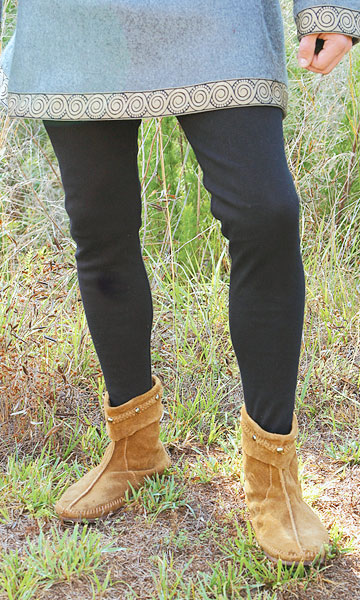Hose
| This article may require cleanup. The specific problem is: Some information is copied directly from an external site. Relevant discussion may be found on the talk page. Please help improve this article if you can. (March 2024) |
Leggings or hose are any of several sorts of fitted clothing to cover the legs. Originally leggings were two separate garments, one for each leg.
Leggings in various forms and under various names have been worn for warmth and protection by both men and women throughout the centuries. The
separate hose worn by men in Europe from the 14th to 16th centuries (the Renaissance period) were a form of leggings, as are the trews of the Scottish Highlands. Separate leggings of buckskin leather were worn by some Native Americans; These were adopted by some Long Hunters, French fur trappers, and later by mountain men. They are the leatherstockings of James Fenimore Cooper's Leatherstocking Tales. The Buckskins, however were mostly a dull grey brain-tan, not the bright, glossy vegetable tanned leather we so commonly see today. It was also common for leggings to be made of light wool.
Cowboys wore leggings of buckskin to protect from chapping caused by riding, wear and tear to their pants, and bites from such animals as snakes or insects in the scruff such as ticks. In many places, especially in colder countries such as ex:Russia or Korea men and women continued to wear wool leggings into modern times, often as an additional outer layer for warmth.
Medieval men did not wear tights – at least not as we know them today...
Medieval codes of modesty required that a man's legs be covered. This was achieved by wearing tight-fitting tubes of cloth (hose). These can simply be described as socks that became so long that they served to cover almost the entire leg. Fundamentally, the reason why the socks got longer and became hose is that as tailoring improved, the tunics worn above became shorter and better fitting requiring greater coverage below.
Hose cover the legs much as tights do, except that the covering for each leg is a separate piece which is then tied onto the baggy under shorts worn above. These were called braises and vaguely resemble a plain pair of boxer shorts. As these socks increased in their length and coverage that of the braises above them shrank correspondingly. Braises eventually evolved into underpants as we know them today.
At the opposite end, each leg would normally terminate in a foot piece which is part of the same garment that covers the leg. This may have merely been made of the same cloth as the rest of the leg or have been reinforced. This could occur through a flat piece of leather being sewn onto the bottom of the foot piece or even being partially wrapped around the foot. It is assumed that commonly a pad of some description would be fixed to the underside of the foot piece if only to stop ones expensive hose from quickly becoming worn out when walking unshod (as was fairly common). Alternately, hose could simply end at the ankle (fairly uncommon) or end in a leather stirrup, which would run under the foot and leave the heel and toes free. There was also a range of separate, additional, pieces of footwear which may have also been worn.
For re-creators of medieval costume and combat it is clear that while being not quite the same, modern tights are a fair facsimile of these, their medieval counterparts – so long as they are not made of fluorescent lycra that is.
Hose are any of various styles of men's clothing for the legs and lower body, worn from the Middle Ages through the seventeenth century, when the term fell out of use in favor of breeches and stockings. (See also trousers.) Early hose were fitted to the leg, and fifteenth century hose were often particolored, having each leg a different color, or even one leg made of two colors. These early hose were footed, in the manner of modern tights, and were open from the crotch to the leg. When very short doublets were in fashion, codpieces were added to cover the front opening.
By the sixteenth century, hose had separated into two garments: upper hose or breeches and nether hose or stockings. From the mid-sixteenth to early seventeenth centuries, a variety of styles of hose were in fashion. Popular styles included:
- Trunk hose or round hose, short padded hose. Very short trunk hose were worn over cannions, fitted hose that ended above the knee.
- Slops or galligaskins, loose hose reaching just below the knee. Trunk hose and slops could be paned or pansied, with strips of fabric (panes) over a full inner layer or lining.
- Pluderhosen, a Northern European form of pansied slops with a very full inner layer pulled out between the panes and hanging below the knee.
- Venetians, semi-fitted hose reaching just below the knee.
